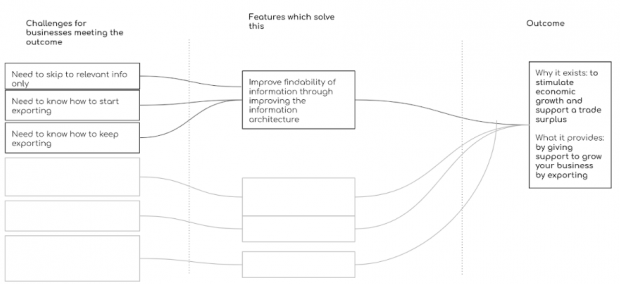
Most people spend less than 15 seconds scanning a website before they decide to stay or go. It has to be clear and compelling what your website or service can do for them in that period of time.
This was the starting point for my talk at the Product People national meet up, the annual conference for product managers working in government. It was my first time speaking at a conference about product management. I wanted to share what I’ve learned about the value of looking at the bigger picture of how a product fits into a wider platform or service.
One of the core parts of being a product manager is working with teams and organisations to ‘define the thing’. We need to define what the problem we are solving is, what the solution is, and how the product is going to deliver that solution. This is the business of creating propositions, which is a core product management skill... but it’s not always simple.
As an example, I asked my audience to consider Facebook Marketplace. I imagine its product manager, whoever they are, has exciting ideas about how that part of the platform could be developed. However, these also need to be balanced against everything else that’s going on for the platform. When someone comes on to Facebook Marketplace, they need to be really clear what the point of it is and how it works. They also need to be clear about how that links to Facebook’s wider proposition. And they need to grasp all this in under 15 seconds or they’ll ‘bounce’!

This kind of problem exists for product managers on any platform that has scaled. For example, if government is trying to give citizens the option to choose between adult education services, I need to make sure that the purpose of my service, its relative benefit over other services, and the department’s services we sit under, are all clear and cohesive to that person. It might not be my job to run the department’s platform, but I certainly need to be working with other product managers to bring that whole experience some cohesion.
My talk covered some actual frameworks and methodologies for doing this, but I wanted to use this blog post to talk about some of the more people-based aspects of building cohesive services.
Share the work
I spoke about using ‘theory of change’ frameworks or ‘logic models’. Essentially, your right hand column shows the desired outcome and your left hand column includes the barriers and user needs that your users have to overcome to get there. In the middle columns, you think about the specific incremental features that might meet those needs and get you to the outcome.

However, the key point is that you should be working through this together, as product teams working under one product lead, or within your teams, or even with your senior stakeholders. Building consensus around your vision makes it much more powerful. It’s very valuable to individual product owners or feature owners to know how they fit into the bigger picture.
Everyone has something to contribute
During one of the panel discussions on the day, Tim Paul spoke about how the language around product managers can be quite hierarchical. We are often called ‘product CEOs’: we ‘make the decisions’ and prioritise what gets built. It can be flattering to see ourselves in this way, but the panel discussed what a disservice to the skills of the team this is if we think we alone own the vision shaping process.
This doesn’t just apply within a product team, but also across multiple product teams. We might not always get time to look up and ask questions about the direction of the wider platform or digital strategy of our organisation. Sometimes we might not feel confident to admit that we don’t know where the strategy is going. Just because someone else has the ‘Lead’ or ‘Head of’ title, doesn’t mean that developing strategy is solely up to them.
It was reassuring to get feedback from other senior product managers at the event that they also agree with this. I would encourage anyone who is not sure about how their work fits into a wider proposition or strategy to just ask – or even suggest to a Product Lead that everyone should work through a vision shaping session together. After all, we are all in the business of being agile and iterating!
Get involved
I know I could be better in doing all the things I’ve just talked about, and the Product People meet up was a good chance to re-learn that. I really enjoyed the chance to be one of the many contributors who spoke throughout the day.
The community is an excellent way to learn about product management as a craft. It's also a good way to get some peer support when working through some of the tough problems we face on projects every day.
If you’re interested in future meetups, follow the #ProductPeople Twitter hashtag, or join the #productmanagement community on the cross government Slack channel.